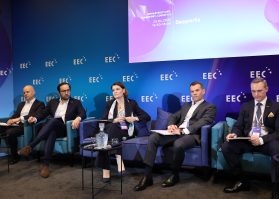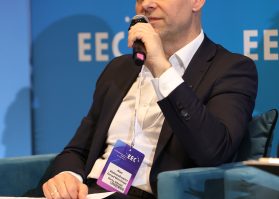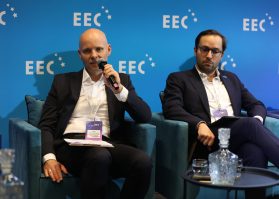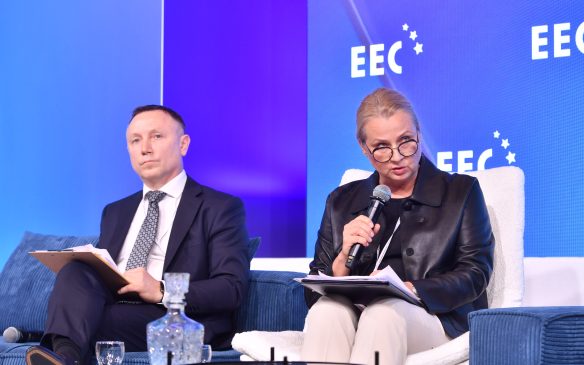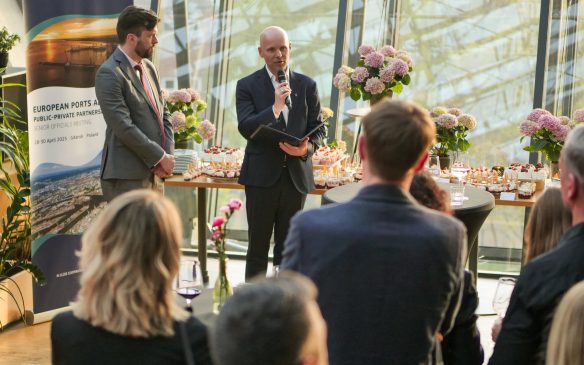The Port of Gdańsk at EEC 2025: seaports generate money from taxes and jobs
Polish ports – what are they like, have they reached their cargo handling capacity, or does Poland need another large seaport? Experts from the maritime and infrastructure industries answered these and other key questions during a lively panel discussion at the European Economic Congress, which shed new light on the future of Polish logistics and maritime transport.
Cargo handling, especially of containerised cargo, continues to grow steadily in Polish ports. Changes in the global trade map mean that they have to think strategically and plan investments decades ahead. Further development of port infrastructure is intended to be the answer to the growing volumes of goods passing through the Port of Gdańsk, as well as the geopolitical and energy challenges faced by Central and Eastern Europe.
The infrastructure investments planned by the Port of Gdańsk are planned to respond to the dynamic changes in the global supply chain and increased demand for the handling of strategic cargoes, ranging from containers and liquid fuels to components for offshore wind farms. Alan Aleksandrowicz, Vice-President of the Port of Gdańsk, emphasised that the activities planned for the next two to three years at the Port of Gdańsk are a continuation of key investment projects.
‘That’s how long the construction alone is set to take, with the design process taking twice as long. A decade, two, or maybe a little more, that’s the timeframe you have to consider when putting together a development strategy. Some key infrastructure projects will begin in the 2030s and, hopefully, finish in the 2040s. We see the need for a new rail and road corridor. We are aware that the design process alone will take years, starting with corridor studies, design concepts and ending with construction’, explained Alan Aleksandrowicz.
He also emphasised that the nearly 17% increase in container handling recorded in the first quarter of this year is in part the result of tests carried out at the new T3 terminal at the Baltic Hub. The new quay has already started cargo handling operations, while work is also underway on T5, an offshore terminal that is due to handle materials for the construction of offshore wind farms. The expansion of Naftoport is about to begin in the Port of Gdańsk, along with the construction of a new station for liquid fuel handling with all the accompanying infrastructure, which along with containers is one of the key cargo groups at the Port of Gdańsk. The Port of Gdańsk also makes use of its existing infrastructure assets.
‘We invest extensively in the Inner Port, in the quays along the Martwa Wisła river. We also want to maximise the potential of the deep-water Outer Port, a place where we do not need to invest billions more in hydro-technical or navigation infrastructure, because we already have it (breakwaters, turntables, and approach fairways) Let me remind you that a single breakwater currently under construction for FSRU costs over PLN 800 million. We want to develop the space between the Baltic Hub and the ore pier, known as ‘Deepwater’. We hope that new cargo groups will appear there. Perhaps a lot of activity will take place in the Rudoport or North Port area, managed by Węglokoks. We also hope that the coal pier will finally be put to use’, said the vice-president of the Port of Gdańsk.
That is why, but also due to the growing importance of intermodal transport, it is crucial to adapt the railway infrastructure to changing logistics needs. This was confirmed by Marcin Mochocki, Investment Implementation Director at PKP PLK, during the panel discussion.
‘Seaports are one of the main drivers of freight and intermodal traffic in Poland. However, their needs continue to evolve. We have a lot of work ahead of us to adapt the railway infrastructure to today’s conditions. PKP Polskie Linie Kolejowe has undertaken a number of measures aimed at improving the efficiency of freight transport, especially in areas of strategic economic importance. We are in intensive talks with, for example, the management board of the Port of Gdańsk about an alternative railway line to the Port of Gdańsk’.
Other ports also invest
The other panellists, representing other Polish ports of strategic importance to the Polish economy, highlighted their own modernisation projects and strategic investments.
Krzysztof Sadowski, vice-president of the Szczecin and Świnoujście port team, spoke about planned investments related to adapting the port infrastructure to the new opportunities offered by the deepened Szczecin-Świnoujście fairway.
‘The decision was made to modernise two basins in the Port of Szczecin: Dębicki and Kaszubski. One of them is a bulk cargo handling area, the other is used for general cargo. The work is carried out on a “living organism”, i.e. in the basins used by port workers every day’.
Katarzyna Gruszecka-Spychała, Vice-President of the Port of Gdynia, spoke about the growing cargo handling, including containerised cargo.
‘This coincides with our plans to develop this area, primarily through the expansion of the outer port, the biggest investment challenge we face. We are currently upgrading the liquid fuel handling station. As a state-owned company, we are responsible for pursuing the specific strategic interests of Poland’.
Does Poland need another large seaport?
‘It would be difficult to declare in advance that a large port will suddenly be built on the central coast of the Baltic Sea. A seaport is an entire ecosystem, a logistics chain that takes decades to develop. It is probably easy to build something. The question is whether the entire logistics chain will be created so that the port actually adds value to the entire national economy. But the subsidiary role of these smaller ports is very much needed and worth developing. I have in mind offshore wind or military mobility. I am sure that one of these smaller ports should be a dual-use port, such as Ustka or Kołobrzeg’, said Alan Aleksandrowicz.
The panel moderator, Ernest Czermański, Director of the Centre for Maritime Economy Research and Head of the Maritime Economy Department at the Faculty of Economics of the University of Gdańsk, noted in his introduction that ports not only serve as cargo handling facilities, but also provide employment.
‘Ports are a window to the economy of the entire country. They are also a place where money is generated from taxes and jobs are created. One job in the port management area alone generates 58 jobs in the port area, and 1,780 jobs in the entire country. This means that with the current employment in Polish port management boards, 1.7 million people work directly or indirectly thanks to the existence of Polish ports’.
Investments in maritime infrastructure are therefore not only an element of transport policy, but also the foundation of Poland’s and Central and Eastern Europe’s security in terms of raw materials, energy and the economy. Structural investments planned many years in advance are a response not only to current market needs, but above all to changing global conditions and the growing importance of the Baltic Sea as a key trade and energy route in this part of Europe.

